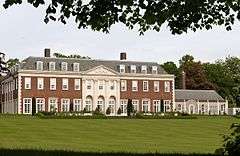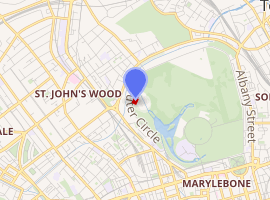Winfield House
Winfield House is an English townhouse in Regent's Park, central London, commissioned in 1936 by American heiress Barbara Hutton. The grounds are 12 acres (4.9 ha); the second-largest private garden in the British capital after that of Buckingham Palace. Since 1955 it has been the official residence of the United States Ambassador. The house is Grade II listed as an "exceptional ambassador's residence and as a notable Neo-Georgian town house containing numerous features of note."[1]
| Winfield House | |
|---|---|
 The garden front in 2009 | |

| |
| Former names | St Dunstan's |
| General information | |
| Architectural style | Neo-Georgian |
| Location | Regent's Park London, England, UK |
| Coordinates | 51.5308°N 0.1644°W |
| Current tenants | US Ambassador to the UK and family (since 1955) |
| Completed | c. 1936 |
| Owner | United States government |
| Design and construction | |
| Architect | Leonard Rome Guthrie |
| Architecture firm | Wimperis, Simpson and Guthrie |
Hertford Villa
The first house on the site was Hertford Villa, the largest of the eight villas originally constructed in the park, in the development scheme of John Nash. This house was designed by Decimus Burton in 1825 for Francis Seymour-Conway, 3rd Marquess of Hertford,[2] who used it for orgies.[3] Burton's creation was described as, 'decorated simplicity, such as the hand of taste, aided by the purse of wealth can alone execute'.[4] Burton's creation was subsequently reconstructed as a building with a modern exterior.[2] Later, the Georgian villa was known as St Dunstan's because of the distinctive clock that hung in front of it, which was purchased by the art-collecting Marquess of Hertford when material from St Dunstan-in-the-West was auctioned off in 1829–30 prior to the church's demolition for a road-widening scheme.[5]
Subsequent occupants of Hertford Villa included American financier Otto Kahn and British newspaper proprietor Lord Rothermere. During the First World War, Kahn lent the house to a new charity for blinded servicemen, which took the name of St Dunstan's.[6] After a fire in 1936, the house was purchased by Barbara Hutton and then demolished.[3]
Winfield House
Hutton commissioned a new mansion to be built in the Neo-Georgian style, which was designed by Leonard Rome Guthrie of the English architectural practice Wimperis, Simpson and Guthrie.[1] The house was at first known by the name of its predecessor (St Dunstan's), but Lord Fraser of Lonsdale, head of the charity, approached Hutton to explain that the similarity in the name and location of her house and his organisation (still with an office in Regent's Park) caused confusion, and he asked that she give up the historical name.[7] She agreed to the request and chose a new name, derived from her grandfather Frank Winfield Woolworth, who had an estate, Winfield Hall, in Glen Cove, New York.[8]
During the Second World War, the house was used by a Royal Air Force barrage balloon unit and as an officer's club. It was visited during the war by film actor Cary Grant, who was married to Hutton at the time. After the war, Hutton sold the house to the American government for one dollar.[3]
After extensive alterations, Winfield House became the ambassador's official residence in 1955. The previous residence at 14 Prince's Gate had been deemed inadequately secure.[9] The house is listed on the U.S. Secretary of State's Register of Culturally Significant Property, which denotes properties owned by the U.S. State Department with particular cultural or historical significance. The interiors have undergone extensive alterations at several points, including in 1969 by William Haines, a decorator and former silent film star.[1]
See also
- List of structures in London
- Shadow Lawn, mansion of Hubert T. Parson, president of the F.W. Woolworth Company
- United Kingdom – United States relations
- U.S. Embassy, London
- Deerfield Residence (Dublin), residence of the US ambassador to Ireland
References
- Historic England. "Winfield House (1389411)". National Heritage List for England. Retrieved 22 July 2011.
- Williams, Guy (1990). Augustus Pugin Versus Decimus Burton: A Victorian Architectural Duel. London: Cassell Publishers Ltd. p. 137. ISBN 0-304-31561-3.
- Stourton. Page 153.
- Jones, Christopher (2017). Picturesque Urban Planning - Tunbridge Wells and the Suburban Ideal: The Development of the Calverley Estate 1825 - 1855. University of Oxford, Department of Continuing Education. p. 209.
- Godwin, George; John Britton (1829). The Churches of London. London.
- My Story of St Dunstan's (1961) by Lord Fraser of Lonsdale
- p. 361 My Story of St Dunstan's (1961) by Lord Fraser of Lonsdale
- "Woolworth". Old Long Island. Retrieved 18 May 2020.
- Horder, John; Pasmore, Stephen (1987), 14 Prince's Gate: Home of the Royal College of General Practitioners, Exeter: Royal College of General Practitioners, pp. 50–51, ISBN 0-85084-124-0
Bibliography
- Stourton, James (2012). Great Houses of London. London: Frances Lincoln. ISBN 978-0-7112-3366-9.
- Tuttle, Maria; Binney, Marcus (2008). Winfield House. London: Thames & Hudson. ISBN 978-0500976784.
External links
| Wikimedia Commons has media related to Winfield House. |
- Official website
- Winfield House (Hertford Villa, St Dunstan's) in the DiCamillo Companion